Have you ever wondered why some food looks so mouthwatering? Their color, brightness, and overall presentation look so rich. So, what is the secret sauce? Thinking of giving all credit to photographers? NO! Food photos are processed in post-production to make them visually attractive and align with the brand goals. Wondering about the procedure of food product image editing for ecommerce. This article gives you a complete idea of how to edit food images, along with some pro tips.
Why Do You Need Food Photo Editing?
No matter how expert a food photographer is, some editing and retouching are a must to create a professional and standard appearance. Let’s learn why you need to edit food images.
Remove Unwanted Elements
Even after being extremely careful, there might be some unavoidable elements present in food images. Eliminating these unnecessary objects is essential to make food photographs well-focused.
Add New Objects
Contextual elements in food images can make it more attractive. You can add various colorful and relevant props to make food visuals more appetizing. Adding a human touch can build an emotional connection.
Adjust Exposure
Neither overexposure nor underexposure are suitable for food photos. The picture may look too dark or too washed out. It can distort food colors and textures. This may misrepresent food products in photos.
Erase Dust and Blemishes
Crumbs, dust, water drops, reflections, etc., often remain unnoticeable in food photos unless you deeply analyze them. Removing these things through editing is necessary to maintain cleanliness and professionalism.
Use Digital Effects
Digital effects in food images can add visual interest. It can be motion effects, levitation, steam/smoke effects, ingredient explosion, etc.
How To Edit Food Photos?
Editing food images needs careful inspection to maintain authenticity. Over-editing can make the food photos bland or monotonous. Let’s learn the correct way of editing food images.
Crop or Resize Food Photos
Cropping or resizing food images is necessary to create a better composition and focus on the subject. It also helps you maintain consistency.
Adjust White Balance
Inappropriate white balance can make food appear unnatural. Adjust the white balance to showcase accurate food color while highlighting important textures and details.
Fine-tune Exposure
Adjust the exposure to achieve optimum brightness level. There should not be any blue or yellow tint. Otherwise, it will negatively impact the color and mood of the image.
Fix Color Scheme
Fine-tune the color scheme to maintain a harmonious presentation. Food’s color should not blend with the background color. Use warm tones for foods. For example, yellow and blue are a popular combination in food photography.
Edit Contrast and Saturation
Modify the contrast and saturation level of food photos to make the color pop and vibrant. But make sure to maintain natural, enticing hues.
Reduce Noise Level
Noise in food photos introduces unwanted artifacts and creates graininess. Optimize the noise level to reduce blurriness.
Adjust Sharpness Level
Keep the food images well-sharp to create crispy and catchy visuals. The texture should look fresh and appetizing. Don’t over-sharpen them. Or they will look unnatural.
Food Photography Tips To Ease Image Editing
- Combine both natural and artificial lights for better control over lighting setup.
- Create a food photography atmosphere that looks organic and authentic.
- Choose a simple but appropriate background that makes the food color pop.
- Use a 45-degree or 3/4 angle for flatter foods, like fast food, salads, drinks, etc.
- An overhead angle is better for foods like desserts and styled dishes.
- A straight-on angle is suitable for tall dishes like cakes, stacked burgers, etc.
- Keep the food arrangement simple and clear to make the presentation balanced.
- Decide whether to use cool or warm colors or both based on the food type.
- Use soft-edged shadows to create a gentle and calming atmosphere.
- Hard-edged shadows are good for creating an indulgent style of food photography.
- Add human elements to produce a sense of interest and scale.
- A small presence of “spritz” can make the food presentation moist and fresh.
- Add freshness elements to evoke healthy eating and stimulate the tastebuds of viewers.
Final Words
Food presentation directly affects the perception of customers regarding quality, taste, and value. Well-presented food items look more attractive to entice viewers. After taking perfect food shots, proper food product image editing for ecommerce is necessary to make them align with your brand integrity. If you are looking for a reliable food image editing service provider, Retouching Zone can be your best partner.










